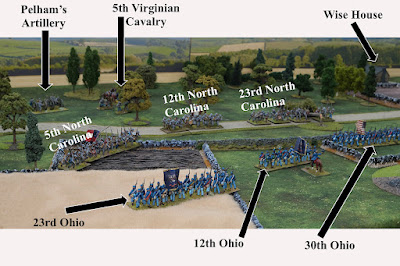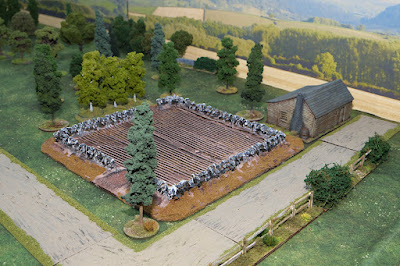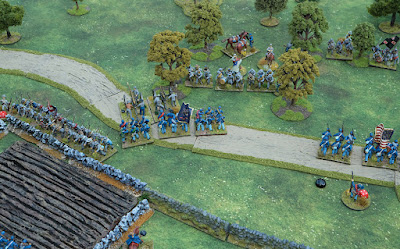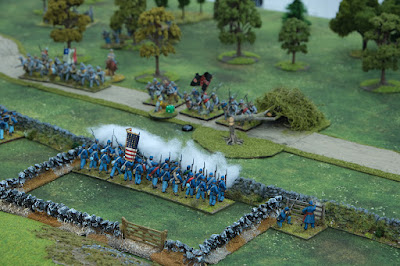This week, in my face-to-face game, I was introduced to the ACW boardgame, Brothers at War, published by Compass games and designed by Christopher Moeller.
The game looks at four small battles from 1862 and offers a total of 13 different scenarios, covering those four battles.
The first thing that struck me was that this game provided the ideal engine to create some figure games for the table without the need for much conversion as the units are generally representing regiments and gun batteries.
In addition, the game is very tactical and itself has something of a figures feel. Anyway, as is my wont, I took a very local slice of action from a situation created in the boardgame and took it to the table.
Please use the ‘read more’ tab to see the rest of this post, which basically follows how the figures game played out.
Last week, we played our first game of Brothers at War at Mike’s. He chose the introductory scenario, Garland's Last Stand from the Fox’s Gap battle. Mike took the Confederates, who have a brigade of fairly low powered units (Garland), plus a very weak cavalry brigade (Rosser).
As the guest, I was given the Union, as they have the responsibility of attack. They start with one brigade (Scammon), which has three regiments and two of them are powerful.
The bigger picture is that this is a 9 turn game (each turn represents 20 minutes). The Union get another brigade (Crook) as a reinforcement on turn 4 and the Confederates get a brigade (Anderson) on turn 8.
It is for the Union to work at getting a victory and this is done by capturing one of two locations, Wise House or Hutzel Farm.
Can the Union act quickly to secure the objective(s) before Confederate reinforcements arrive?
A couple of turns in and the game had given us this situation. The Union having taken up positions behind a series of stone walls are preparing to launch their first assault against Garland, the Union reinforcements have not arrived yet.
30th Ohio had previously thrown out a skirmisher screen to secure part of the wall, giving time for the rest of the regiment to move up next to them.
At this point in the game, the necessity was for Scammon to deal with Garland’s brigade and frankly the odds look in their favour to do that and in our boardgame, it transpired that Garland was eventually dealt a devastating blow, losing the brigade.
 |
| Click for detail |
For the figures game, I am refreshing my memory with the Black Powder II rule set from Warlord Games, so this small engagement is just the ticket. The boardgame has a system of hits and saves, which of course is a bedrock of the Black Powder system, so that gives us a tie between the two games.
 |
| Wise House and field |
The boardgame uses chit draw to randomise the order that brigades activate in, so at the start of play, I will roll a D6, to see who will be Player 1 for the game ….. it could be a very short game if the Union win that roll!
Special attributes and notes:
The Confederate artillery is underpowered, so I will handle it as a half battery (small unit). The Union 23rd Ohio and 30th Ohio are notably big units, as are the Confederate 5th North Carolina, so they will be designated large units.
The Confederate 5th Virginian Cavalry will be handled as a small unit. In play, they start dismounted with a horse holder base.
The boardgame has some cards that bring in various random events. I will deal one of those cards to each force just as a token recognition of that element of the game and fudge them if need-be to properly assimilate them to the BP rules.
Black Powder is designed for big games on big tables, but this game will show how flexible the rules are - just three Union units, this is the sort of thing that most collections can stretch to, so something for everyone here.
The Game.
The Union win the die roll for 1st Player and immediately this looks like it could be a short game as 30th Ohio get off a devastating volley against 23rd North Carolina, both shaking and disordering them.
The Confederates pull back into the woods. This obliges 30th Ohio to advance. If they are to see off Garland’s brigade, they need to attack. On the Confederate right, 5th North Carolina advance towards the cornfield to attack 5th Ohio, but in view of how the game is unfolding, this is an unwise move that really only serves to stretch Garland’s command as most of the Confederate line is retiring.
It is not long before 5th N.C. are obliged to fall back to take up cover behind the wall of the ploughed field, though Pelham’s artillery is trying to get forward to support them.
30th Ohio make a very determined effort to follow up 23rd N.C. As they close on the wood edge, they not only take fire from 23rd, but the 5th Cavalry have worked their way to the wood edge on the Union left and the cavalry pour fire into 30th’s flank.
30th become disordered and continue to suffer casualties. In the end, they are forced to retire back to the safety of the wall.
While this was going on, Pelham had brought his artillery up, but before they could unlimber, 12th Ohio, jumped the wall and ran at the guns, seeing them off, in full rout.
 |
| Pelham's guns are struck while trying to unlimber! |
This was just an odd, bright little moment in an otherwise failing Union attack and 12th had to almost immediately fall back to the wall to keep the Union front aligned.
With Union now back at their starting positions and the Confederates not wanting to leave the woods, it looked on the face of it like a stalemate, but it was a victory for the Confederates, as they had survived and their reinforcements were not far away.
Conclusions.
This was an enjoyable little action that took a couple of hours to play out. Initially it looked like an uneven match, one that only the Union could win, but, there we are!
It is easy to think that 3 units for the Union and 5 for the Confederates is unlikely to give a decent game, especially with something like Black Powder, which is designed for multiple brigade encounters, but there was plenty of nuance going on here and most units managed to hang on longer than I would have thought likely.
The Confederates managed to play their card (Rally Round the Flag), but the Union didn't (a skirmisher related card). I'm not a big fan of cards, but I do like Random Event tables ... so work that one out! :-)
Usually the temptation when setting up throw down ACW scenario is to put loads of snake fencing out, so it made an interesting change to have so much stone walling instead. This feature makes for a natural defensive line and anchor point for the Union in both the boardgames and the figures game.
I have since bought a copy of the boardgame for myself, so will go back to those rules now, have a full re-read, which after our recent playing, should embed themselves to memory pretty easily. I rather fancy that the next post might be taking a closer look at the boardgame system.
Resource Section.
My sister webspace ‘COMMANDERS’ showcase the various figure and boardgame systems that I am enjoying and gives a flavour of where current projects are up to. Link.







